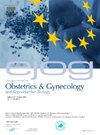超声特征与体外受精妊娠早期妊娠丢失相关
IF 1.9
4区 医学
Q2 OBSTETRICS & GYNECOLOGY
European journal of obstetrics, gynecology, and reproductive biology
Pub Date : 2025-10-06
DOI:10.1016/j.ejogrb.2025.114759
引用次数: 0
摘要
研究问题:能否在体外受精(IVF)妊娠中建立早期妊娠丢失(EPL)接近100%阳性预测值(PPV)的基于胎龄的超声标准?DesignA回顾性队列研究在一家学术IVF诊所进行,包括2014年至2021年间胚胎移植后妊娠试验阳性的所有患者。Logistic回归评估胎龄和超声标记物(胎囊、胚胎、心脏活动)与EPL之间的关系。约登指数确定了每个标记的最佳胎龄分界点。结果共纳入913例患者,平均年龄35.5±4.8岁,平均BMI为27.6±6.5 kg/m2。大多数在囊胚期进行冷冻单胚胎移植;15.1%的患者进行了非整倍体植入前基因检测(PGT-A)。结果包括727例活产(79.6%),176例早产(19.3%),3例死产和7例终止妊娠。没有妊娠囊或胚胎44天,或心脏活动46天,EPL的ppv分别为100%,100%和97%。Logistic回归证实,在特定的胎龄切割点,EPL缺失标记物的几率增加:44天无胎囊(OR 5.52, 95% CI[3.40-8.94]), 44天无胚胎(OR 5.88, CI[3.64-9.49]), 46天无心脏活动(OR 2.86, CI[1.99-4.12])。结论在IVF妊娠中,已知胎龄可以较早诊断EPL,而传统标准仅基于超声标记物。需要更大规模的研究来验证这些建议的标准,并将其与传统的EPL诊断标准进行比较。本文章由计算机程序翻译,如有差异,请以英文原文为准。
Sonographic characteristics associated with early pregnancy loss in pregnancies conceived via in vitro fertilization
Research Question
Can gestational age–based sonographic criteria with near 100% positive predictive value (PPV) for early pregnancy loss (EPL) be established in pregnancies conceived via in vitro fertilization (IVF)?
Design
A retrospective cohort study was conducted at a single academic IVF clinic, including all patients with a positive pregnancy test following embryo transfer between 2014 and 2021. Logistic regression assessed associations between gestational age and presence of sonographic markers (gestational sac, embryo, cardiac activity) with EPL. Youden’s Index identified optimal gestational age cut-points for each marker.
Results
The study included 913 patients (mean age 35.5 ± 4.8 years; mean BMI 27.6 ± 6.5 kg/m2). Most underwent frozen single embryo transfer at the blastocyst stage; 15.1 % had preimplantation genetic testing for aneuploidy (PGT-A). Outcomes included 727 live births (79.6 %), 176 EPLs (19.3 %), 3 stillbirths, and 7 terminations. Absence of a gestational sac or embryo by 44 days, or cardiac activity by 46 days, yielded PPVs for EPL of 100 %, 100 %, and 97 %, respectively. Logistic regression confirmed increased odds of EPL with absent markers at the specified gestational age cut-points: absence of a gestational sac at 44 days (OR 5.52, 95 % CI [3.40–8.94]), absence of an embryo at 44 days (OR 5.88, CI [3.64–9.49]), and absence of cardiac activity at 46 days (OR 2.86, CI [1.99–4.12]).
Conclusions
In IVF pregnancies, known gestational age may allow for earlier diagnosis of EPL, as compared to traditional criteria, which are based upon sonographic markers alone. Larger studies are needed to validate these proposed criteria and compare them to traditional criteria for diagnosis of EPL.
求助全文
通过发布文献求助,成功后即可免费获取论文全文。
去求助
来源期刊
CiteScore
4.60
自引率
3.80%
发文量
898
审稿时长
8.3 weeks
期刊介绍:
The European Journal of Obstetrics & Gynecology and Reproductive Biology is the leading general clinical journal covering the continent. It publishes peer reviewed original research articles, as well as a wide range of news, book reviews, biographical, historical and educational articles and a lively correspondence section. Fields covered include obstetrics, prenatal diagnosis, maternal-fetal medicine, perinatology, general gynecology, gynecologic oncology, uro-gynecology, reproductive medicine, infertility, reproductive endocrinology, sexual medicine and reproductive ethics. The European Journal of Obstetrics & Gynecology and Reproductive Biology provides a forum for scientific and clinical professional communication in obstetrics and gynecology throughout Europe and the world.

 求助内容:
求助内容: 应助结果提醒方式:
应助结果提醒方式:


